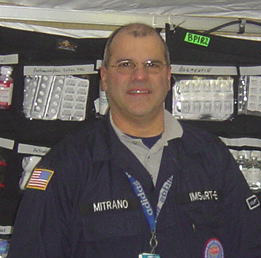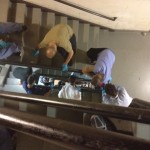Uncle Sam Wants YOU for Disaster Relief
Pharmacists Serving Important Roles on DMATs, IMSuRTs

AS NEWS SPREADS OF THE DEVASTATION wrought by the earthquakes in Haiti and Chile this winter, many pharmacists wondered what they could do to help. One option was joining the National Disaster Medical System, which is part of the U.S. Federal Response Plan. Responding to a disaster or other emergency is grueling work, but pharmacists who are healthy and can pass a background check can qualify to be on a Disaster Medical Assistance Team (DMAT) or an International Medical Surgical Response Team (IMSuRT).
DMAT personnel provide care ranging from triage to preparing patients for evacuation. Although DMATs are designed primarily to provide help in their own regions, they also assist in other parts of the country as needed and may deploy to disaster sites around the world, usually in conjunction with an IMSuRT.
Can You Rough It?
Serving on a DMAT or an IMSuRT is fulfilling, but it is no easy task, according to Shannon Manzi, Pharm.D., team leader for emergency services and combined programs at Children’s Hospital Boston. Manzi is a member of DMAT MA-1 and has deployed on seven missions, most recently to Haiti.
“You have to be very flexible,” she said, noting that you may not have a bed to sleep in or a shower for several weeks, you eat military MREs (meals ready to eat), and often work 12- to 16-hour shifts.
“You dig toilets, carry boxes, and set up tents,” Manzi said. “Whether you’re a brain surgeon, a medical technician, or a pharmacist, it’s all the same job, all in a very austere environment.” There are three IMSuRTs, each of which has a rapid-assembly hospital that includes mobile equipment and supplies. IMSuRT personnel stabilize patients, perform surgery, provide critical care, and prepare patients for evacuation.

To an untrained eye, field pharmacies may look like organized chaos, but they serve DMATs and IMSuRTs pharmacists well.
Members of DMATs and IMSuRTs are activated for two weeks at a time. During their deployments, members are considered federal employees, and their regular jobs are protected by federal law.
Creativity Part of Job Description
During deployments, pharmacists must use all of their pharmacy knowledge and problem-solving skills, according to Manzi. “Items may be in limited supply, and there may be no sterile area. You may end up rationing or using things in novel ways,” she said. For example, in Haiti, Manzi created rehydration solution with the salt and sugar packets that came with the MREs.
The work is not without its risks, said Erasmo (Ray) Mitrano, M.S., associate chief of pharmacy, inpatient operations, at Massachusetts General Hospital in Boston, who deployed with IMSuRT East to Haiti.
“It’s easy to forget about yourself in that kind of situation, but if you don’t eat, drink, and get rest, then you aren’t going to be able to help others,” he said, recalling how several team members in Haiti had to be treated for dehydration.
If you are interested in joining a team, Mitrano suggests that you talk to someone who is already a member. “Get an overall understanding of what the commitment really is,” he said. “It’s an honor to serve, but getting onto a team is a long, involved process.”
Indeed, it is not something that pharmacists can just sign up for and start doing. A candidate must either be sponsored by an existing team member or have two professional letters of recommendation. This is followed by several interviews and background checks.
Candidates accepted and assigned to a team then undergo extensive training that includes incident command courses, online courses, and hands-on instruction in assembling equipment and setting up field hospitals. All told, the entire process can take nine months.
“We do need a bigger pool of pharmacists,” Mitrano said. “If you are interested, now would be a great time to look into it—before disaster strikes.” ![]()










 If you want to contribute tutorials, news or other stuff please contact us. We pay 150 for each approved article.
If you want to contribute tutorials, news or other stuff please contact us. We pay 150 for each approved article. Consectetur adipisicing elit. Sed do eiusmod tempor incididunt ut labore.
Consectetur adipisicing elit. Sed do eiusmod tempor incididunt ut labore. This site uses valid HTML and CSS. All content Copyright © 2010 Newscast, Inc
This site uses valid HTML and CSS. All content Copyright © 2010 Newscast, Inc If you like what we do, please don't hestitate and subscribe to our
If you like what we do, please don't hestitate and subscribe to our